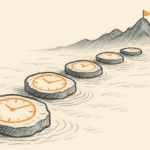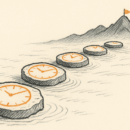The aid circus is back in town
The shilling did its dance of joy last month, in anticipation (I’m told) of wonderfully large aid flows that will wash up on our shores in a matter of weeks. Our currency, like us, waits with begging-bowl outstretched. In business and government circles, the talk is the same: we’ll be OK because aid is on its way. Call me a killjoy, but I find this very worrying indeed.
Why? Consider this: according to World Bank figures, Kenya received an annual average of US$ 200 million in foreign aid in the 1970s; over US$ 600 million in the 1980s; and nearly US$ 1 billion in the early 1990s. These figures leave me reeling. At the peak of our aid-fest, we were receiving net aid inflows of US$ 40 per person per year – 14% of our Gross Domestic Product (GDP) and a staggering 45% of the government budget. We were awash in aid, and were receiving it from all-comers.
What on earth did we do with it? Look at us today: street-kids on every corner; infrastructure in tatters; education system in crisis; health care in the intensive care unit. What we do have, however, is a collection of ridiculously conceived, poorly implemented, ultimately abandoned ‘white elephant’ projects dotted all over the country. We also have a coterie of politicians and businessmen who managed to get their snouts into the aid trough and have enough money to last their families three generations or more. That’s what we have to show for the golden years when the aid gravy train was steaming through the land.
We are not alone in this experience. Donors poured a colossal US$ 2 billion into building roads in Tanzania over 20 years. If you’ve been to that country, I think you’ll agree that it does not have a road network that reflects even 10 per cent of that amount. The Congo Republic (formerly Zaire) also received decades of large-scale foreign assistance; this money was flowing at the same time as when its leader, Mobutu Sese Seko, was amassing one of the world’s largest personal fortunes in foreign banks. Look at Congo today: it is an unmitigated disaster of a country where the billions of dollars of aid appear to have left not a trace.
It is not that donor-funded projects lack in ambition: the Kenana sugar complex in Sudan is a case in point. In his book ‘Lords of Poverty’, author Graham Hancock showed that the project was the largest scheme of its kind ever created. It was conceived in 1974, when a feasibility study put the costs of the project at US$ 150 million; it finally started producing sugar in 1981, by when the final bill had risen to US$ 613 million. The World Bank had insisted that Sudan should produce more foreign exchange, and Kenana was meant to export sugar on a large scale. But the plant is situated on the White Nile smack in the middle of a burning desert, nearly a thousand miles from the nearest port. The transportation cost element makes Kenana sugar uneconomic in an international market characterised by over-supply. The sugar is now sold almost exclusively in Sudan, at a price far higher than that of imported sugar.
How is this happening? How do the world’s best economists and engineers produce such total disasters? To understand this, we must look at why aid is given in the first place. Is it out of altruism and a genuine desire to improve the lot of the world’s poor? If only. If the world’s rich countries are generous, it is only because they wish to invest in their own futures. They see us as suppliers of resources and consumers of products. They invest accordingly – in political links greased with large aid cheques.
Why did Kenya and Zaire receive such munificent support in the 1970s and 1980s? Quite simply, because the Cold War with the Soviet Union was at its peak and we were seen as strategic allies who would provide a bulwark against the relentless spread of communism. Why else were we still getting our annual cheques when our record of human-rights abuse was at its worst in the late 1980s and early 1990s? Did America and Britain not know about the torture chambers in the Nyayo House dungeons? Of course they did; it was just more convenient to look the other way. As the Berlin Wall fell, however, and the Soviet Union crumbled, suddenly the emphasis switched to good governance and protection of human rights. What had changed? Just the fact that we had nothing of political value left to offer.
Politics aside, aid is big business. The UN, IMF and World Bank are huge institutions in their own right. They have gigantic bureaucracies to run, offices to maintain and payrolls to meet. They have highly paid personnel who fly around the world to identify targets for their largesse. You may have met them: they come off their business-class flights and climb into their chauffer-driven four-wheel drive vehicles. They check into luxury hotels in Nairobi and hold workshops with government bigwigs. They are here to do deals and justify their own existence; they must find virtuous projects to fund and nice politicians to support. And find them they do, unless the politicians they come across are irredeemable gluttons and the projects are conceived by cretins – which was the case in Kenya until very recently.
Now, with our new government in place, the aid circus is back in town. Goodwill visits, agreeable seminars and secret negotiations are the order of the day again. It is not a question of if the aid will flow again, but when. I was alarmed to see President Kibaki, at the height of his illness just after coming to power, hauling himself out of his sickbed to meet somebody called Michael Ancram. Who is this man? Surely you’ve heard of him? Why, he’s the deputy leader of the opposition Conservative Party in the UK! His equivalent in Kenya is (allegedly) Bonaya Godana. If good old Bonaya decided to fly off for a quick sojourn to the UK, their Prime Minister, the honourable Tony Blair, would definitely cancel all his commitments to meet him, would be not? Ha! This begging business is truly an undignified thing.
Yet Mr. Kibaki is an intelligent man, and an intelligent man always has a plan. We do need the money, at least initially. We are likely to have a serious budget deficit for a few years as we haul this country back on to its feet. The aid money will bridge that gap most admirably. But that is where it must end. We must never again make ourselves hopeless aid junkies looking for our next fix of the tantalising drug.
Indeed, we must be like the South Korea of the 1960s, which used American aid very, very effectively: on schools, roads, health care and telecommunications. But it simultaneously developed its own strategies and its own capabilities, and emerged as an economic powerhouse in its own right. The aid circus moved on as Korea moved up.
If we are not careful, aid will ‘crowd out’ our own ability to think for ourselves. Our future lies in our own hands, not in the briefcases of visitors. It is our own people, our own ideas and our own determination that will make us great. I pray that our leaders know this.

Buy Sunny Bindra's new book
The X in CX
here »
Popular Posts
- Where are you rushing to—your funeral?June 29, 2025
- The map will appear—once you start walking.July 6, 2025
- How to spot a real thinkerJune 15, 2025
- Built the app, forgot the flowJune 22, 2025











